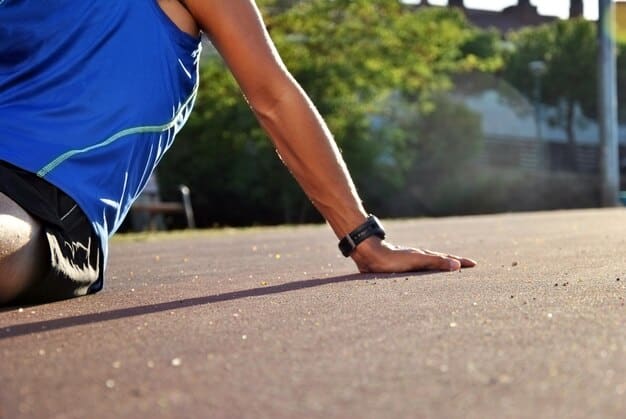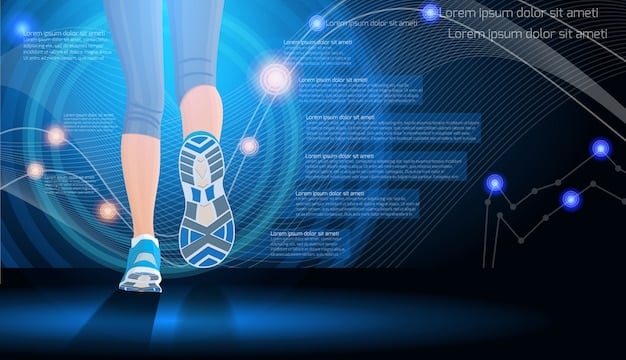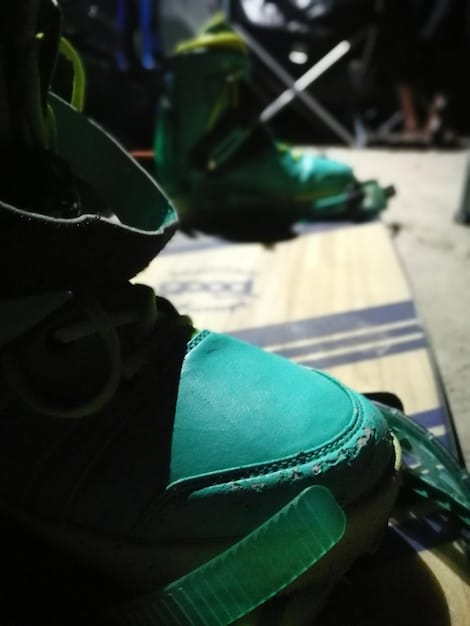New Shoe Tech: Cutting Marathon Times by 2 Minutes in 2025?

The impact of new shoe technology on marathon times continues to be a significant topic, with speculation rising about whether runners can shave off an additional two minutes by 2025, driven by advancements in materials, design, and biomechanical understanding.
The quest to run faster marathons has always been at the forefront of athletic innovation. Could the impact of new shoe technology on marathon times lead to runners trimming an astonishing two minutes off their personal best by 2025? Let’s dive into the details.
The Evolution of Marathon Shoe Technology
Marathon shoe technology has undergone radical changes in recent years. From simple, flat soles to complex, high-tech designs, the journey has been one of continuous innovation. Understanding this evolution is crucial to predicting future advancements.
Early Innovations in Running Shoes
The early days of running shoes saw minimal technology. Simple rubber soles and basic cushioning were the norm. It wasn’t until the mid-20th century that advancements began to pick up pace.
The Introduction of Lightweight Materials
A major turning point was the introduction of lightweight materials like nylon and EVA foam. These materials reduced the weight of the shoes, allowing runners to exert less energy with each stride.
- Nylon Uppers: Offered better breathability and reduced weight compared to traditional materials.
- EVA Foam: Provided improved cushioning and shock absorption.
- Impact Reduction: These innovations collectively helped reduce the impact on joints, minimizing the risk of injuries.
The transition to lighter and more cushioned shoes marked a significant improvement in marathon performance. Runners could maintain their pace for longer periods, leading to faster overall times.

The Rise of Carbon Fiber Plates
The introduction of carbon fiber plates revolutionized marathon shoe technology. These plates provide a spring-like effect, propelling runners forward and increasing their efficiency. This technology has been a game-changer.
How Carbon Fiber Plates Work
Carbon fiber plates are embedded in the midsole of the shoe. They are designed to flex and return energy, essentially acting as a lever that helps propel the runner forward. This reduces the amount of energy the runner needs to expend.
The Impact on Running Economy
Studies have shown that carbon fiber plates can improve running economy by as much as 4%. For a marathon runner, this can translate into a significant reduction in time.
- Increased Propulsion: The plates provide a measurable boost in each stride.
- Reduced Energy Expenditure: Runners use less energy over the course of the race.
- Faster Times: These factors combine to produce faster marathon times.
The benefits of carbon fiber plates are undeniable, with many elite runners adopting this technology. This has spurred further research and development in the field, pushing the boundaries of what’s possible.
Advanced Foam Technology
Alongside carbon fiber plates, advanced foam technology plays a crucial role in modern marathon shoes. These foams offer superior cushioning and energy return, further enhancing performance. The combination of foam and plates is where the magic happens.
PEBA (Polyether Block Amide) Foams
PEBA foams, such as those used in Nike’s ZoomX technology, are known for their exceptional energy return. These foams compress and rebound quickly, providing a responsive and efficient ride.
TPU (Thermoplastic Polyurethane) Foams
TPU foams, like Adidas’ Boost technology, offer a good balance of cushioning and durability. While not as responsive as PEBA foams, they provide reliable performance over long distances.
- Superior Cushioning: Reduces impact and protects joints.
- High Energy Return: Returns energy to the runner, increasing efficiency.
- Lightweight Design: Keeps the shoe light, reducing fatigue.
The development of these advanced foams has complemented the carbon fiber plate technology, resulting in shoes that are both fast and comfortable. This combination is essential for achieving peak performance in a marathon.
Biomechanical Optimizations
Shoe technology isn’t just about materials; it’s also about design. Biomechanical optimizations aim to enhance the natural movement of the runner, reducing strain and improving efficiency. Understanding the body is key.
Rocker Geometry
Rocker geometry involves shaping the sole of the shoe in a curved manner. This design encourages a smoother transition from heel to toe, reducing the amount of energy needed for each stride.
Optimized Heel-to-Toe Drop
The heel-to-toe drop refers to the difference in height between the heel and the toe of the shoe. Optimizing this drop can improve running posture and reduce stress on the Achilles tendon.
- Smoother Transitions: Rocker geometry aids in a more natural stride.
- Improved Posture: Optimized drop can enhance running form.
- Reduced Strain: These optimizations minimize the risk of injuries.
By focusing on biomechanical principles, shoe manufacturers are creating designs that work in harmony with the runner’s body, maximizing efficiency and minimizing the risk of injury.
The Two-Minute Barrier: Is It Achievable?
The question remains: can all these technological advancements really help runners shave off two minutes from their marathon times by 2025? While it’s an ambitious goal, it’s not entirely out of reach.
Current Performance Trends
Looking at recent marathon performances, it’s clear that shoe technology is already having a significant impact. Many elite runners are consistently achieving faster times, thanks in part to these advancements.
Potential for Further Innovation
There’s still plenty of room for further innovation. New materials, improved designs, and better understanding of biomechanics could all contribute to even faster marathon times.

- Material Science: New foams and plate materials could further enhance energy return.
- Design Optimization: More sophisticated designs could improve biomechanical efficiency.
- Personalization: Customized shoes tailored to individual running styles could offer a competitive edge.
While a two-minute reduction is a challenging target, the ongoing advancements in shoe technology suggest that it’s a realistic possibility. The next few years will be crucial in determining whether this goal can be achieved.
Challenges and Considerations
Despite the potential benefits of new shoe technology, there are also challenges and considerations to keep in mind. These include the cost of the shoes, the risk of injury, and the ethical implications of using performance-enhancing technology.
Cost and Accessibility
High-tech marathon shoes can be expensive, making them inaccessible to many runners. This raises questions about fairness and equity in the sport.
Risk of Injury
While new shoe technology can improve performance, it can also increase the risk of injury. Runners need to gradually adapt to these shoes and be mindful of their bodies.
It’s crucial to consider these factors when assessing the impact of shoe technology on marathon times. While the potential benefits are clear, it’s important to ensure that these advancements are accessible, safe, and fair for all runners.
| Key Point | Brief Description |
|---|---|
| 🚀 Carbon Fiber Plates | Revolutionary tech offering spring-like propulsion. |
| 👟 Advanced Foams | PEBA and TPU foams provide superior cushioning and energy return. |
| 🏃 Biomechanical Optimizations | Rocker geometry enhances natural movement, reducing strain. |
| 💰 Cost & Accessibility | High costs raise concerns about fairness in the sport. |
FAQ
▼
Carbon fiber plates are lightweight, stiff inserts embedded in the midsole of running shoes. They act as a lever, enhancing propulsion and increasing running efficiency by reducing energy loss during each stride.
▼
Advanced foams like PEBA and TPU offer superior cushioning and energy return. They compress and rebound quickly, reducing impact on joints and providing a responsive, efficient ride, crucial for long distances.
▼
Rocker geometry is the curvature of the shoe’s sole, promoting a smoother transition from heel to toe. This design reduces the energy needed for each stride, aiding a more natural and efficient running motion.
▼
While beneficial, these shoes may increase injury risk if not adapted to properly. Runners should gradually transition to high-tech shoes, paying attention their body and adjusting training to prevent overuse issues.
▼
Yes, ongoing research and development in materials, biomechanics, and design ensure further innovations. Expect to see more personalized and efficient running shoes that push the boundaries of marathon performance.
Conclusion
In conclusion, the impact of new shoe technology on marathon times is undeniable. While the goal of shaving off two minutes by 2025 is ambitious, ongoing advancements in materials, design, and biomechanics suggest it’s a realistic possibility. As technology continues to evolve, it’s essential to consider the ethical, economic, and safety implications to ensure a fair and accessible playing field for all runners.